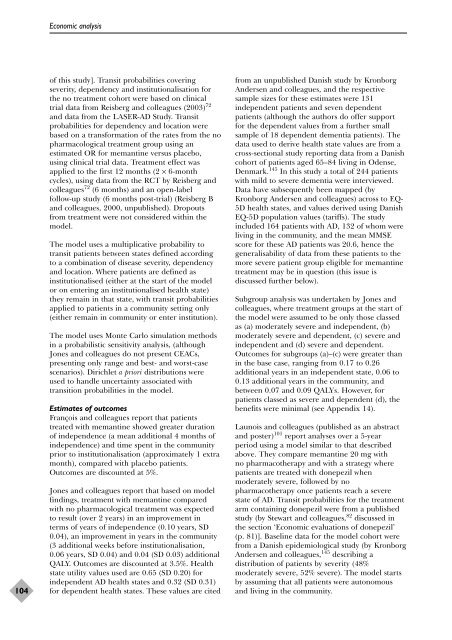Donepezil, rivastigmine, galantamine and memantine for ...
Donepezil, rivastigmine, galantamine and memantine for ...
Donepezil, rivastigmine, galantamine and memantine for ...
You also want an ePaper? Increase the reach of your titles
YUMPU automatically turns print PDFs into web optimized ePapers that Google loves.
104<br />
Economic analysis<br />
of this study]. Transit probabilities covering<br />
severity, dependency <strong>and</strong> institutionalisation <strong>for</strong><br />
the no treatment cohort were based on clinical<br />
trial data from Reisberg <strong>and</strong> colleagues (2003) 72<br />
<strong>and</strong> data from the LASER-AD Study. Transit<br />
probabilities <strong>for</strong> dependency <strong>and</strong> location were<br />
based on a trans<strong>for</strong>mation of the rates from the no<br />
pharmacological treatment group using an<br />
estimated OR <strong>for</strong> <strong>memantine</strong> versus placebo,<br />
using clinical trial data. Treatment effect was<br />
applied to the first 12 months (2 × 6-month<br />
cycles), using data from the RCT by Reisberg <strong>and</strong><br />
colleagues 72 (6 months) <strong>and</strong> an open-label<br />
follow-up study (6 months post-trial) (Reisberg B<br />
<strong>and</strong> colleagues, 2000, unpublished). Dropouts<br />
from treatment were not considered within the<br />
model.<br />
The model uses a multiplicative probability to<br />
transit patients between states defined according<br />
to a combination of disease severity, dependency<br />
<strong>and</strong> location. Where patients are defined as<br />
institutionalised (either at the start of the model<br />
or on entering an institutionalised health state)<br />
they remain in that state, with transit probabilities<br />
applied to patients in a community setting only<br />
(either remain in community or enter institution).<br />
The model uses Monte Carlo simulation methods<br />
in a probabilistic sensitivity analysis, (although<br />
Jones <strong>and</strong> colleagues do not present CEACs,<br />
presenting only range <strong>and</strong> best- <strong>and</strong> worst-case<br />
scenarios). Dirichlet a priori distributions were<br />
used to h<strong>and</strong>le uncertainty associated with<br />
transition probabilities in the model.<br />
Estimates of outcomes<br />
François <strong>and</strong> colleagues report that patients<br />
treated with <strong>memantine</strong> showed greater duration<br />
of independence (a mean additional 4 months of<br />
independence) <strong>and</strong> time spent in the community<br />
prior to institutionalisation (approximately 1 extra<br />
month), compared with placebo patients.<br />
Outcomes are discounted at 5%.<br />
Jones <strong>and</strong> colleagues report that based on model<br />
findings, treatment with <strong>memantine</strong> compared<br />
with no pharmacological treatment was expected<br />
to result (over 2 years) in an improvement in<br />
terms of years of independence (0.10 years, SD<br />
0.04), an improvement in years in the community<br />
(3 additional weeks be<strong>for</strong>e institutionalisation,<br />
0.06 years, SD 0.04) <strong>and</strong> 0.04 (SD 0.03) additional<br />
QALY. Outcomes are discounted at 3.5%. Health<br />
state utility values used are 0.65 (SD 0.20) <strong>for</strong><br />
independent AD health states <strong>and</strong> 0.32 (SD 0.31)<br />
<strong>for</strong> dependent health states. These values are cited<br />
from an unpublished Danish study by Kronborg<br />
Andersen <strong>and</strong> colleagues, <strong>and</strong> the respective<br />
sample sizes <strong>for</strong> these estimates were 131<br />
independent patients <strong>and</strong> seven dependent<br />
patients (although the authors do offer support<br />
<strong>for</strong> the dependent values from a further small<br />
sample of 18 dependent dementia patients). The<br />
data used to derive health state values are from a<br />
cross-sectional study reporting data from a Danish<br />
cohort of patients aged 65–84 living in Odense,<br />
Denmark. 145 In this study a total of 244 patients<br />
with mild to severe dementia were interviewed.<br />
Data have subsequently been mapped (by<br />
Kronborg Andersen <strong>and</strong> colleagues) across to EQ-<br />
5D health states, <strong>and</strong> values derived using Danish<br />
EQ-5D population values (tariffs). The study<br />
included 164 patients with AD, 132 of whom were<br />
living in the community, <strong>and</strong> the mean MMSE<br />
score <strong>for</strong> these AD patients was 20.6, hence the<br />
generalisability of data from these patients to the<br />
more severe patient group eligible <strong>for</strong> <strong>memantine</strong><br />
treatment may be in question (this issue is<br />
discussed further below).<br />
Subgroup analysis was undertaken by Jones <strong>and</strong><br />
colleagues, where treatment groups at the start of<br />
the model were assumed to be only those classed<br />
as (a) moderately severe <strong>and</strong> independent, (b)<br />
moderately severe <strong>and</strong> dependent, (c) severe <strong>and</strong><br />
independent <strong>and</strong> (d) severe <strong>and</strong> dependent.<br />
Outcomes <strong>for</strong> subgroups (a)–(c) were greater than<br />
in the base case, ranging from 0.17 to 0.26<br />
additional years in an independent state, 0.06 to<br />
0.13 additional years in the community, <strong>and</strong><br />
between 0.07 <strong>and</strong> 0.09 QALYs. However, <strong>for</strong><br />
patients classed as severe <strong>and</strong> dependent (d), the<br />
benefits were minimal (see Appendix 14).<br />
Launois <strong>and</strong> colleagues (published as an abstract<br />
<strong>and</strong> poster) 101 report analyses over a 5-year<br />
period using a model similar to that described<br />
above. They compare <strong>memantine</strong> 20 mg with<br />
no pharmacotherapy <strong>and</strong> with a strategy where<br />
patients are treated with donepezil when<br />
moderately severe, followed by no<br />
pharmacotherapy once patients reach a severe<br />
state of AD. Transit probabilities <strong>for</strong> the treatment<br />
arm containing donepezil were from a published<br />
study (by Stewart <strong>and</strong> colleagues, 82 discussed in<br />
the section ‘Economic evaluations of donepezil’<br />
(p. 81)]. Baseline data <strong>for</strong> the model cohort were<br />
from a Danish epidemiological study (by Kronborg<br />
Andersen <strong>and</strong> colleagues, 145 describing a<br />
distribution of patients by severity (48%<br />
moderately severe, 52% severe). The model starts<br />
by assuming that all patients were autonomous<br />
<strong>and</strong> living in the community.
















